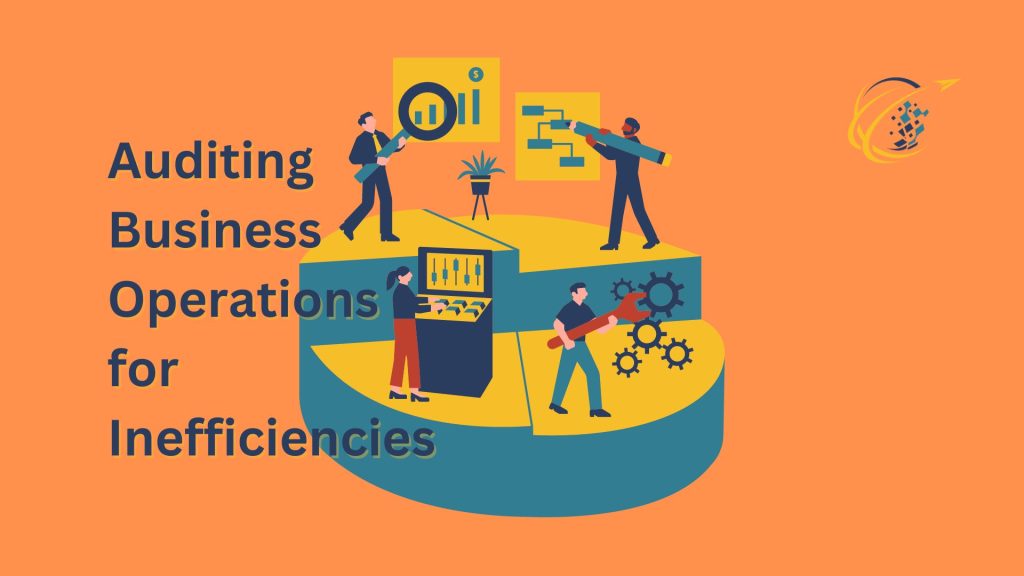Auditing business operations for inefficiencies is a way that companies can keep their finger on the pulse of their asset. Companies that fail to regularly audit their processes for inefficiencies risk falling behind in an increasingly competitive landscape. Auditing business operations is not merely about cutting costs. It’s also about enhancing productivity, streamlining workflows, and ultimately delivering better value to customers. This process involves a thorough examination of various operational aspects. Continuously monitor workflow bottlenecks, resource allocation, technology usage, and employee performance. By identifying and addressing these inefficiencies, businesses can improve their day-to-day operations. They can also foster a culture of continuous improvement. Below we’ll get into key areas that are essential for auditing business operations effectively. This will provide actionable insights for businesses looking to optimize their performance and stay ahead of the curve.
Identifying Bottlenecks in Workflow
Identifying bottlenecks in workflow is a critical step in auditing business operations for inefficiencies. Bottlenecks occur when a particular point in a process slows down or stops the flow of work. This hinders productivity and delays delivery. To effectively identify these problematic areas, businesses need to meticulously analyze each step of their operations.
Firstly, mapping out the entire workflow process is essential. This visual representation allows managers to see where delays typically occur. For instance, if multiple tasks consistently pile up at a certain stage, it is likely a bottleneck. Additionally, by observing the sequence of operations, businesses can pinpoint where resources or information are waiting. This is also an indicator of potential inefficiencies.
Gathering input from employees can provide invaluable insights into where they perceive delays or excessive complexities within their daily tasks. Engaging with staff through interviews or feedback sessions helps to identify overt bottlenecks. It also helps to find subtler areas of inefficiency that may not be evident from a managerial perspective.
Moreover, data analysis can aid in validating suspected bottlenecks. By reviewing performance metrics such as time to completion and error rates, businesses can quantify the impact of each stage of their process. This quantitative analysis helps confirm which steps need restructuring or additional resources to alleviate delays.
The identification of bottlenecks is a vital component of auditing business operations for inefficiencies. Through workflow mapping, employee feedback, and data analysis, businesses can pinpoint these critical areas. Addressing these bottlenecks not only enhances productivity but also improves overall operational effectiveness, paving the way for smoother, more efficient business processes.
Analyzing Resource Allocation
Analyzing resource allocation is a crucial aspect of auditing business operations for inefficiencies. Effective management of resources such as time, labor, and materials is essential for maximizing productivity and reducing waste. By evaluating how businesses distribute and utilize these resources, they can identify areas that need improvement and make strategic adjustments to enhance overall efficiency.
Firstly, it is fundamental to understand how to allocate time across various tasks and projects. Businesses need to assess whether the time spent on certain activities is proportional to their importance and contribution to the organization’s goals. For instance, excessive time spent on low-priority tasks can divert attention and resources from critical objectives, leading to inefficiencies.
Similarly, labor allocation requires scrutiny. It involves analyzing whether managers have assigned the right number of employees with the appropriate skills to each task. Misalignment here can lead to overstaffing, resulting in unnecessary labor costs, or understaffing, which can cause delays and lower the quality of work.
Additionally, managers must optimize the management of materials to prevent overstocking, which ties up capital, or understocking, which can halt production lines. Regular reviews of inventory levels, supply chain operations, and procurement strategies are necessary to ensure materials are purchased and utilized efficiently, avoiding both excess and scarcity.
A thorough analysis of how resources are allocated is integral to auditing business operations for inefficiencies. By closely examining the distribution and use of time, labor, and materials, businesses can identify wasteful practices and implement more effective strategies. This not only reduces costs but also enhances the agility and responsiveness of the organization, strengthening its competitive edge in the market.
Evaluating Technology and Tools
Evaluating technology and tools is an essential component of auditing business operations for inefficiencies. In today’s rapidly evolving technological landscape, using outdated or inefficient tools can significantly hinder a company’s productivity and competitiveness. Regular assessment of these tools is crucial to determine if they are still serving the intended purpose or if they require upgrades or replacements to enhance operational efficiency.
Firstly, businesses need to review the functionality and performance of their current technology. This includes examining software, hardware, and other tools used in daily operations. If technology is found to be lagging, causing delays, or not integrating well with other systems, it can create bottlenecks that impair workflow and productivity. Therefore, identifying these issues is the first step toward remediation.
Moreover, investing in new technology can lead to significant improvements in efficiency. Modern tools often come with enhanced features that automate tasks, reduce errors, and provide superior data analytics. For example, upgrading to a more sophisticated CRM system can streamline customer relationship management processes, enabling more personalized and efficient service.
Additionally, the integration capabilities of new technologies should be considered. Seamless integration helps in creating a more cohesive and efficient workflow, allowing different tools and platforms to communicate effectively. This not only saves time but also reduces the likelihood of errors, enhancing overall operational efficiency.
A thorough evaluation of the existing technology and tools is pivotal in identifying areas where upgrades or replacements can significantly impact efficiency. By staying updated with the latest technological advancements and ensuring that tools are functioning optimally, businesses can mitigate inefficiencies and strengthen their position in the market. This proactive approach is essential for maintaining productivity and driving business growth.
Reviewing Communication Channels
Reviewing communication channels is a vital aspect of auditing business operations for inefficiencies. Effective communication within an organization is crucial for ensuring that all team members are aligned with the company’s goals and processes, which in turn enhances operational efficiency. A thorough review of the existing communication strategies can identify gaps and provide insights into potential improvements.
Effective internal communication ensures that information flows seamlessly between departments and levels of hierarchy. When communication channels are clear and open, it reduces misunderstandings and errors that can delay projects and decision-making processes. For instance, regular updates and feedback loops help keep all team members informed about project statuses and changes, enabling them to adapt and respond swiftly.
Moreover, the adoption of modern communication tools can significantly enhance the speed and clarity of these interactions. Tools such as instant messaging platforms, collaboration software, and project management tools can facilitate more efficient exchanges of information, allowing for real-time collaboration and quicker resolution of issues.
Additionally, it is crucial to tailor communication strategies to fit the needs of different departments and teams. What works for one group may not be effective for another, depending on the nature of their work and their specific communication requirements. Regular audits of these strategies can help identify the most effective methods for each team, ensuring that information is shared efficiently and appropriately across the organization.
A comprehensive review of communication channels is essential for identifying and addressing inefficiencies within an organization. By optimizing these channels and employing effective strategies, businesses can significantly enhance operational efficiency, reduce delays, and improve overall productivity. This strategic focus on communication is not only beneficial for immediate operational needs but also supports long-term organizational success.
Monitoring and Improving Employee Performance
Monitoring and improving employee performance is an integral part of auditing business operations for inefficiencies. Effective performance management not only enhances individual employee output but also contributes significantly to the overall productivity of the organization. Establishing clear performance metrics, providing continuous feedback, and offering targeted training are key strategies in this process.
Firstly, setting clear expectations is fundamental. Employees perform best when they understand what is expected of them. Clearly defined goals and objectives ensure that all team members are aligned with the company’s strategic direction and have a clear understanding of their roles. This clarity helps in measuring performance effectively and identifying areas where expectations are not being met.
Moreover, regular feedback is crucial for performance improvement. Constructive feedback helps employees recognize their strengths and areas for improvement. It should be timely and specific, focusing on observable behaviors and outcomes rather than personal traits. This ongoing process encourages a culture of continuous improvement and helps prevent minor issues from developing into significant problems.
Additionally, implementing training programs to address deficiencies plays a crucial role in enhancing efficiency. Tailored training initiatives can help bridge the gap between current performance levels and desired outcomes. Whether it’s on-the-job training, professional development courses, or mentoring programs, investing in employee development not only improves individual skills but also boosts overall organizational capacity.
Actively monitoring and improving employee performance is essential for minimizing inefficiencies within business operations. By setting clear expectations, providing structured feedback, and facilitating appropriate training, organizations can foster a productive work environment where continuous improvement is the norm. This proactive approach is vital for maintaining competitiveness and achieving long-term success.
Conclusion
In conclusion, auditing business operations for inefficiencies is a multifaceted process that encompasses various crucial areas. From identifying bottlenecks in workflow and analyzing resource allocation to evaluating technology and enhancing communication channels, each aspect plays a vital role in streamlining operations. Furthermore, monitoring and improving employee performance is essential for achieving operational excellence. Implementing these strategies effectively not only addresses current inefficiencies but also sets a foundation for sustainable growth and productivity. Businesses that commit to regular audits and continuous improvement are better positioned to adapt to changes in the market environment and maintain a competitive edge. Ultimately, the goal of such audits is to ensure that every facet of the organization operates at its highest potential, driving overall success and profitability.



